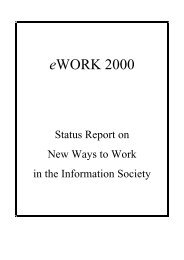Proceedings of 8th European Assembly on telework (Telework2001)
Proceedings of 8th European Assembly on telework (Telework2001)
Proceedings of 8th European Assembly on telework (Telework2001)
You also want an ePaper? Increase the reach of your titles
YUMPU automatically turns print PDFs into web optimized ePapers that Google loves.
180Short summaries <str<strong>on</strong>g>of</str<strong>on</strong>g> the other presentati<strong>on</strong>s in the sessi<strong>on</strong>New structure – better work?Harri Melin, Pr<str<strong>on</strong>g>of</str<strong>on</strong>g>essor, University <str<strong>on</strong>g>of</str<strong>on</strong>g> Tampere, FinlandJacques Babot and John Sherwin (EU DG Informati<strong>on</strong> Society and DG Employment and SocialAffairs) presented the results <str<strong>on</strong>g>of</str<strong>on</strong>g> the pilot project “From Pilot Project to Standard Practice – ThePlanned Introducti<strong>on</strong> <str<strong>on</strong>g>of</str<strong>on</strong>g> e-Work to the <str<strong>on</strong>g>European</str<strong>on</strong>g> Commissi<strong>on</strong>” dealing with <strong>telework</strong> within theEU Commissi<strong>on</strong>. The Commissi<strong>on</strong> started their pilot project in January 1999 and it lasted for a yearand a half. The total number <str<strong>on</strong>g>of</str<strong>on</strong>g> <strong>telework</strong>ers was about 120. The <strong>telework</strong> was part-time, and bothhome-based and mobile by nature.Internal and external experts later evaluated the project. According to the internal report, <strong>telework</strong>could make a valuable c<strong>on</strong>tributi<strong>on</strong> by improving the efficiency <str<strong>on</strong>g>of</str<strong>on</strong>g> the Commissi<strong>on</strong> and thequality <str<strong>on</strong>g>of</str<strong>on</strong>g> the working life <str<strong>on</strong>g>of</str<strong>on</strong>g> its staff. Attenti<strong>on</strong> should be given to a strategy for a more generalintroducti<strong>on</strong> <str<strong>on</strong>g>of</str<strong>on</strong>g> <strong>telework</strong>ing opti<strong>on</strong>s for the majority <str<strong>on</strong>g>of</str<strong>on</strong>g> the Commissi<strong>on</strong>’s staff. The external reportc<strong>on</strong>cluded that the pilot project had been undertaken pr<str<strong>on</strong>g>of</str<strong>on</strong>g>essi<strong>on</strong>ally and effectively, and it producedvery clear and unambiguous results. Immediate acti<strong>on</strong> should be taken to extend <strong>telework</strong>ingopti<strong>on</strong>s throughout the Commissi<strong>on</strong> as widely and rapidly as possible.The staff that participated in the pilot project has been c<strong>on</strong>tinuing <strong>telework</strong>ing since the end <str<strong>on</strong>g>of</str<strong>on</strong>g>the project. Experiments with more sophisticated technological support are also being c<strong>on</strong>ducted.Evaluati<strong>on</strong> reports have been circulated widely, the findings have been presented, and the role <str<strong>on</strong>g>of</str<strong>on</strong>g><strong>telework</strong> has been c<strong>on</strong>firmed in the <strong>on</strong>going reform programme. Telework will be an element in thefuture development <str<strong>on</strong>g>of</str<strong>on</strong>g> the e-Commissi<strong>on</strong>.Birgitte Yttri and John W. Bakke (Telenor Research and Development) talked about “Working inPrivate and Public Spaces”. Their starting point was that <strong>telework</strong> and other forms <str<strong>on</strong>g>of</str<strong>on</strong>g> flexible workchallenge the traditi<strong>on</strong>al distincti<strong>on</strong>s between work and n<strong>on</strong>-work activities, as well as the receivedunderstanding <str<strong>on</strong>g>of</str<strong>on</strong>g> where work is to take place. In their presentati<strong>on</strong>, they discussed boundary workin <strong>telework</strong>, delineating work and leisure, and relati<strong>on</strong>ship management in private, public andsemi-public places. The presentati<strong>on</strong> was based <strong>on</strong> the results <str<strong>on</strong>g>of</str<strong>on</strong>g> three Norwegian and <str<strong>on</strong>g>European</str<strong>on</strong>g>projects.In “traditi<strong>on</strong>al work spaces” it is assumed that work tasks, and work tasks <strong>on</strong>ly, will be performedin their designated spaces. The daily schedule <str<strong>on</strong>g>of</str<strong>on</strong>g> a “traditi<strong>on</strong>al worker” is clearly divided intodifferent locati<strong>on</strong>s and activities. The daily schedule <str<strong>on</strong>g>of</str<strong>on</strong>g> a <strong>telework</strong>er is mixed or blurred in terms <str<strong>on</strong>g>of</str<strong>on</strong>g>locati<strong>on</strong> and activity. You work at home and you also have your leisure at home.Telework challenges the traditi<strong>on</strong>al distincti<strong>on</strong>s. Telework and other forms <str<strong>on</strong>g>of</str<strong>on</strong>g> flexible workingdecouple the close links between time, schedule, locati<strong>on</strong> and activity. Telework also necessitatesnew forms <str<strong>on</strong>g>of</str<strong>on</strong>g> time, locati<strong>on</strong> and activity management. According to the surveys, there are twomain strategies: 1) Segmentators distinguish sharply between work and n<strong>on</strong>-work. 2) Integrators








